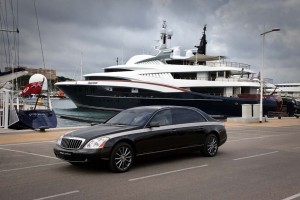
Have ultra-luxury cars, like the $500,000 Maybach Zeppelin, lost their cache during this era of frugality?
Eight years after the launch of its ultra-luxurious Maybach brand, can Daimler AG afford to keep the lesser-known competitor to Rolls-Royce and Bentley going?
Sales of the super-premium brand have been steadily declining, since shortly after Maybach made its debut, in the 2003 model-year, leading more than a few industry analysts to speculate about its long-term viability.
Company insiders point to the launch of the new 2010 Maybach Zeppelin as a sign of their commitment to the brand, and insist that despite its modest volumes, the premium marque is delivering cash to Daimler’s bottom line. But whether the company is willing to keep the Maybach brand going indefinitely is a question that is left hanging.
It’s been a difficult time for virtually all high-line luxury automakers Maybach officials won’t release sales data for the current year, but they acknowledge that volumes have been on the slide since their record of 500 cars sold shortly after launch. By 2007 that was down to 400 and, last year, the number tumbled to 300. But as global brand manager Patrick Marinoff wass quick to point out, Maybach isn’t unique. Bentley, for example, is likely to finish the year off as much as 40% from its 2007 peak of more than 10,000 vehicles.
“People still have the money” to buy such high-line vehicles, “but don’t want to show off so ostentatiously,” especially during the current economic crisis, Marinoff suggested. But he also concedes that, at least in older markets, such as Western Europe and the U.S., that were traditionally the center of demand for ultra-luxury automobiles, “The car is no longer the status symbol for the super-rich to differentiate themselves anymore.”
Nonetheless, Marinoff believes there are some opportunities for Daimler’s most exclusive marque, particularly in emerging markets, from the Middle East to China, the latter suddenly being seen as having the biggest growth opportunities for luxury vendors of all sorts, from Gucci to de Beers to Maybach.
It will take time to build up those markets, Marinoff acknowledged, during a drive of the newest Maybach offering, the $500,000 Zeppelin.
Does the brand have the time needed? That’s the question for Joe Phillippi, long-time automotive analyst and now the head of AutoTrends Consulting. Estimating this year’s sales will be closer to just 200, Phillippi said, “I find it hard to imagine they can make money at that level,” even though the Maybach shares a significant level of its componentry with the Mercedes-Benz S-Class.
That is, in fact, the dark secret of the Maybach brand. While its various models, such as the 57, 62 and, now, the Zeppelin, boast unique sheet metal, paint and some distinct features, such as the 62’s electroluminescent roof, the underlying platform is a modified version of a two generation-old S-Class. And Maybach shares much of the rest of its systems with Mercedes, significantly reducing development and purchasing costs.
That’s one reason, said Maybach manager Marinoff, the brand can fare well even now. “Each and every car that goes out delivers a nice (financial) contribution,” he asserted during a stopover in the French perfume capital of Grasse. Nonetheless, if the weak volumes of 2009 were to continue, “It would be difficult,” Marinoff admitted.
Maybach’s business strategy, since its launch, has been to “steadily go up-market,” the executive pointed out. That’s in contrast to its two primary rivals. After the two brands split and were sold off, a decade ago, the Volkswagen-owned Bentley put its primary focus on the “down-market” Continental line, which starts around $150,000. Rolls-Royce, now owned by BMW, initially emphasized top-line products, such as the Phaeton sedan, but is about to launch the smaller, $250,000 Ghost.
“Do we need” something similar? Marinoff asked, immediately offering an answer of his own. “At some point in time…there are possibilities.”
Selling that option to the parent company likely wouldn’t be very easy anytime soon, observers caution. Daimler is under enormous financial pressure, especially with Mercedes-branded products suffering sharp sales declines in most key markets, this year.
But without a broader reach, “I’m not sure the (Maybach) brand can stand alone in this environment,” contended analyst Phillippi.
The original Maybach concept vehicle was shown with a Mercedes badge on its back, the car first conceived as a model that would ride above the S-Class. Daimler strategists concluded that there wasn’t enough elasticity in the Mercedes brand and decided to build a separate brand entirely around Maybach, which revived the name of one of Germany’s most exclusive auto manufacturers from before the Second World War.
Right now, Maybach marketers are turning to some unusual means to boost volume. The Zeppelin media preview was staged at the same hotel, along France’s elegant Cote d’Azure, where several dozen current or former Maybach owners were being wined and dined in hopes of getting them to purchase a Zeppelin.
Several, in conversations with TheDetroitBureau.com, said they were strongly leaning towards making the purchase. And in the rarified atmosphere that Maybach competes in, that would be a big score for the brand. But it will still take a lot more such events to build Maybach into a truly competitive operation.
